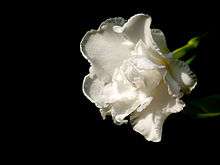Tabernaemontana divaricata
| Tabernaemontana divaricata | |
|---|---|
 | |
| Crape Jasmine | |
| Scientific classification | |
| Kingdom: | Plantae |
| (unranked): | Angiosperms |
| (unranked): | Eudicots |
| (unranked): | Asterids |
| Order: | Gentianales |
| Family: | Apocynaceae |
| Subfamily: | Rauvolfioideae |
| Genus: | Tabernaemontana |
| Species: | T. divaricata |
| Binomial name | |
| Tabernaemontana divaricata R.Br. ex Roem. & Schult. | |
Tabernaemontana divaricata (Apocynaceae), commonly called pinwheelflower,[1] crape jasmine, East India rosebay and Nero's crown[2] is an evergreen shrub native to India and now cultivated throughout South East Asia and the warmer regions of continental Asia. In zones where it is not hardy it is grown as a house/glasshouse plant for its attractive flowers and foliage. The stem exudes a milky latex when broken, whence the name milk flower (দুধফুল), টগর or কাঠমল্লিকা in the Bengali language..
It is called as ‟నందివర్దనం” ‟ Nandi Vardhanam” in Telugu language and "நந்தியார்வட்டை" "Nandiar vattai" in Tamil and "Nanthyaar vattam" (നന്ത്യാർവട്ടം) in Malayalam and Nandi battalu (ನಂದಿ ಬಟ್ಟಲು) in the Kannada language. Other Indian names include chandni and taggar. It is known as wathusudda වතුසුද්ද (meaning "Garden White") in the Sinhalese language. In Cambodia, it is called phka nuon srei ផ្កានួនស្រី or phka dâk khut ផ្កាដកឃុត.[3] The plant contains several alkaloids and, like many other Apocynaceae, is toxic and medicinal.
Synonyms
- Ervatamia coronaria (Jacq.) Stapf
- Ervatamia divaricata (L.) Burkill
- Ervatamia flabelliformis Tsiang
- Ervatamia recurva (Roxb. ex Lindl.) Lace
- Ervatamia siamensis (Warb. ex Pit.) Kerr
- Jasminum zeylanicum Burm.f.
- Kopsia cochinchinensis Kuntze
- Nerium coronarium Jacq.
- Nerium divaricatum L.
- Nyctanthes acuminata Burm.f.
- Reichardia grandiflora Dennst.
- Reichardia jasminoides Dennst.
- Taberna discolor (Sw.) Miers
- Tabernaemontana citrifolia Lunan
- Tabernaemontana coronaria (Jacq.) Willd.
- Tabernaemontana discolor Sw.
- Tabernaemontana flabelliformis (Tsiang) P.T.Li
- Tabernaemontana gratissima Lindl.
- Tabernaemontana indica Willd. ex Roem. & Schult. [Illegitimate]
- Tabernaemontana lurida Van Heurck & Müll.Arg.
- Tabernaemontana recurva Roxb. ex Lindl.
- Tabernaemontana siamensis Warb. ex Pit.
- Testudipes recurva (Roxb. ex Lindl.) Markgr.
- Vinca alba Noronha[4]

Description
The plant generally grows to a height of 5–6 feet (1.5–1.8 m) and is dichotomously-branched. The large shiny leaves are deep green and about 6 inches (15 cm) in length and 2 inches (5.1 cm) in width. The waxy blossoms are found in small clusters on the stem tips. The (single) flowers have the characteristic 'pinwheel' shape also seen in other genera in the family Apocynaceae such as Vinca and Nerium. Both single and double-flowered forms are cultivated, the flowers of both forms being white. The plant blooms in spring but flowers appear sporadically all year. The flowers of the single form are unscented but the double-flowered form has a pleasing fragrance.[5]
The roots have a bitter taste.
The leaves of this plant are eaten by the caterpillars of the Oleander Hawk-moth (Daphnis nerii).
 Tabernaemontana divaricata 'Flore Pleno'
Tabernaemontana divaricata 'Flore Pleno' Crape jasmine bunch
Crape jasmine bunch Tabernaemontana divaricata 'Pinwheel'
Tabernaemontana divaricata 'Pinwheel' Tabernaemontana divarcata yet to blossom
Tabernaemontana divarcata yet to blossom caterpillar of Oleander Hawk-moth feeding on pinwheel flower plant
caterpillar of Oleander Hawk-moth feeding on pinwheel flower plant
Traditional medicine
They are used in Ayurvedic medicine and the traditional medicine of South East Asia, the Malay Peninsula, Indonesia, and Ambon Island.
Chemical constituents
Plant has been reported to contain a variety of alkaloids, including, in the bark of the stem and root including tabernaemontanine, coronarine, coronaridine, and dregamine. Alkaloids are present in all the vegetative parts of this shrub.[6]
References
- ↑ "Tabernaemontana divaricata". Natural Resources Conservation Service PLANTS Database. USDA. Retrieved 7 December 2015.
- ↑ Medicinal Plants of India and Pakistan, Dastur J.F., pub.1962 by D.P. Taraporevala Sons and Co. Private Ltd., Mumbai, 4th Indian reprint 1977
- ↑ Mathieu LETI, HUL Sovanmoly, Jean-Gabriel FOUCHÉ, CHENG Sun Kaing & Bruno DAVID, Flore photographique du Cambodge, Toulouse, Éditions Privat, 2013, p. 97.
- ↑ "The Plant List: A Working List of All Plant Species".
- ↑ The Royal Horticultural Society Dictionary of Gardening ed. Chittenden,Fred J. 2nd ed. by Synge,Patrick M. Volume IV : Pt-Zy, p.2074 (as T. coronaria). Pub. Oxford at the Clarendon Press 1965. Reprinted 1984. ISBN 0-19-869106-8
- ↑ Perry, Lily M. (1980). Medicinal Plants of East and Southeast Asia: Attributed Properties and Uses. MIT Press. ISBN 978-0-262-16076-6.
External links

